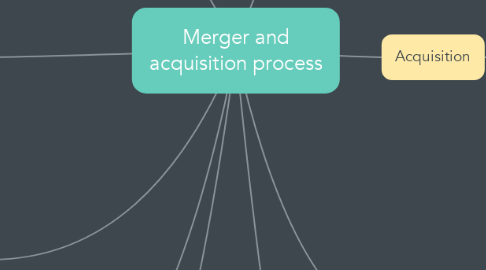
1. Merger
1.1. Is an operation used to unify investments and commercial criteria of two companies of the same branch or of similar objectives.
1.2. It is the agreement of two or more legally independent companies.
2. Reasons for mergers or acquisitions
2.1. Deben ubicarse en el contexto más amplio de las estrategias de negocios y empresariales
2.2. They must be placed in the broader context of business and business
2.3. The justification for these processes is given based on the objectives of the business and entrepreneurial strategies.
3. Description of the process for mergers and acquisitions
3.1. Decision making for the business union consists of two perspectives: the rationalist and the one based on the organizational process.
3.2. The importance of the target company to the strategic plans of the merging or acquiring firm is important.
4. Search and selection
4.1. The objective is to know all the companies that appear as candidates to be acquired or merged to make way for an evaluation.
4.2. Identify the criteria on which the selection of candidates will be based, create profiles and collect relevant data.
5. Proposal
5.1. This phase is critical for the process, since it is necessary to establish minimum and maximum limits than the acquirer.
5.2. When valuing a company, there are four important elements to consider:
5.2.1. * The capital of the shareholders. * The value, according to its books, projected in the long term. * The value of the brand in the market. The synergistic value that the company will bring to the acquirer or merger.
6. types
6.1. Pures:Two or more companies of an equivalent size agree to join, creating a new company to which they contribute all their resources; dissolving primitive companies. (A + B = C)
6.2. Fusion by absortion:: One of the companies involved (absorbed) disappears, integrating its assets into the absorbing company. The absorbing company (A), continues to exist, but accumulates to its equity that corresponding to the absorbed company (B).
6.3. Establecer los limites sobre el precio máximo a pagar o lo que se determine pueda costear la empresa, ayuda de manera significativa a no perder perspectiva.
7. Mergers and acquisitions have acquired strategic plans.
7.1. They form strategic alliances to achieve certain objectives and maintain the level of competitiveness in a globalized market
8. Acquisition
8.1. Defines the process carried out by a company when take operational control of another.
8.2. An acquisition is deemed to have been completed at the time a organization has sufficient control over the other company.
8.3. An acquisition, these can be:
8.3.1. Friendly. When the initial offer is accepted.
8.3.2. Answered. When there is more than one offer to consider.
8.3.3. Hostile. When control of the target company is obtained without the support of its management or the Board of Directors.
9. Type of relationship .
9.1. established between companies, they can be classified into:
9.1.1. Horizontal: Companies are competitors to each other and belong to the same industry. Gap (acquired Banana Republic and launched the Old Navy brand) ... Colpatria-Scotiabank. ... Coca-Cola (acquisition of Jugos del Valle) ... Mattel and Fisher Price
9.1.2. Vertical: Companies are located in different phases of the complete cycle of exploitation of a product Zara, the most important and representative brand of the Spanish group Inditex is a case study in the fashion world that, unlike the vast majority of its competitors, bases its model on a balanced vertical integration strategy (forward and backward). ). In the case of technology companies, Apple stands out and is a hitherto difficult example to imitate for many of its competitors when it comes to vertical integration. And it is that although several companies to some degree have tried to implement this type of strategies, the company based in Cupertino has been in charge over the last years of having under its command the control of tasks and activities that are key to Maintain their competitive advantage and provide a significantly different user experience compared to what other brands offer.
9.1.3. Conglomerate mergers occur when two organizations sell their products in completely different markets. There may be little or no synergy between your product lines or business areas. The benefit of a conglomerate merger is the new parent organization raising diversity in its business portfolio. A shoe company may team up with a manufacturer of water filters, according to business theory they would rarely go down in both markets at the same time. Many companies are built considered in this theory.
